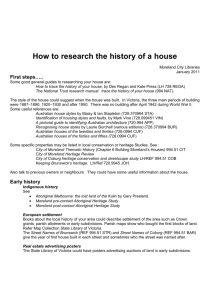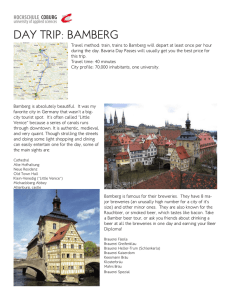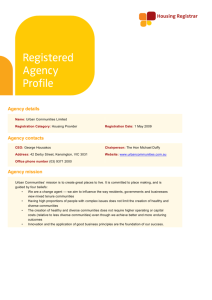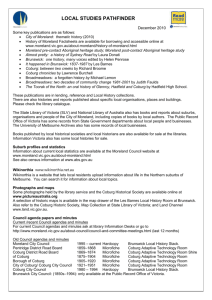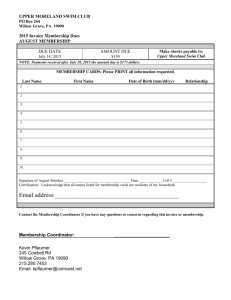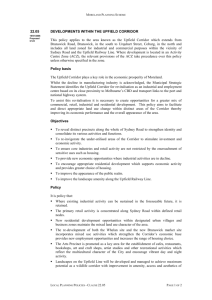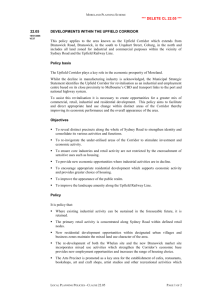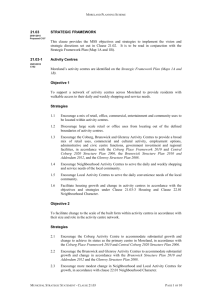Welcome to Inside Moreland A message from your Mayor Hello
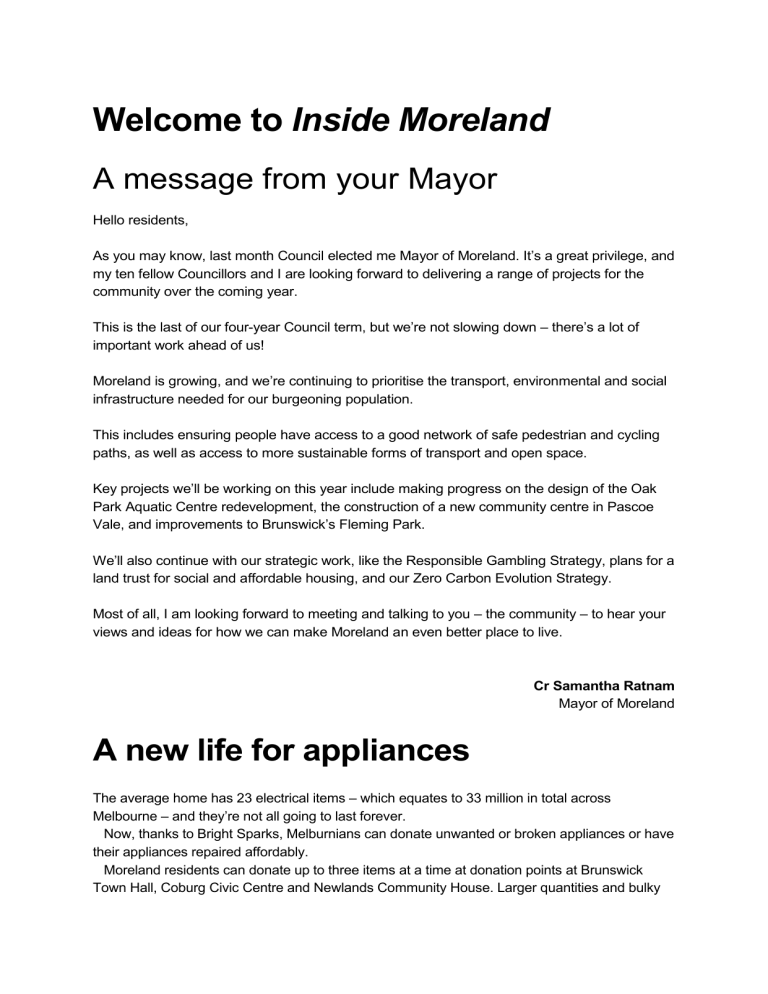
Welcome to Inside Moreland
A message from your Mayor
Hello residents,
As you may know, last month Council elected me Mayor of Moreland. It’s a great privilege, and my ten fellow Councillors and I are looking forward to delivering a range of projects for the community over the coming year.
This is the last of our fouryear Council term, but we’re not slowing down – there’s a lot of important work ahead of us!
Moreland is growing, and we’re continuing to prioritise the transport, environmental and social infrastructure needed for our burgeoning population.
This includes ensuring people have access to a good network of safe pedestrian and cycling paths, as well as access to more sustainable forms of transport and open space.
Key projects we’ll be working on this year include making progress on the design of the Oak
Park Aquatic Centre redevelopment, the construction of a new community centre in Pascoe
Vale, and improvements to Brunswick’s Fleming Park.
We’ll also continue with our strategic work, like the Responsible Gambling Strategy, plans for a land trust for social and affordable housing, and our Zero Carbon Evolution Strategy.
Most of all, I am looking forward to meeting and talking to you – the community – to hear your views and ideas for how we can make Moreland an even better place to live.
Cr Samantha Ratnam
Mayor of Moreland
A new life for appliances
The average home has 23 electrical items – which equates to 33 million in total across
Melbourne – and they’re not all going to last forever.
Now, thanks to Bright Sparks, Melburnians can donate unwanted or broken appliances or have their appliances repaired affordably.
Moreland residents can donate up to three items at a time at donation points at Brunswick
Town Hall, Coburg Civic Centre and Newlands Community House. Larger quantities and bulky
small appliances such as microwaves and vacuum cleaners can be taken to Bright Sparks HQ, which is located at 1 Walter Street in Hadfield.
Televisions are not accepted at Bright Sparks, however the National Television and Computer
Recycling Scheme has created a number of drop off points for the free recycling of TVs and computers across Victoria. To check your closest TV drop-off point visit moreland.vic.gov.au/recycling-tv.
Last year alone Australians threw out about 20kg of e-waste per person, which is more than
468,000 tonnes in total. Many of the items thrown out were in working order, and others could have been easily repaired.
For more information visit brightsparksaustralia.com or phone Bright Sparks on 0432 202 123.
More jobs and homes for Coburg
All Coburg residents know their suburb was a pretty different place 50 years ago. A California bungalow could be snatched up for a steal, and newly arrived families from Italy, Greece, Lebanon and Turkey were making the suburb home.
People lived modestly, but there were plenty of jobs nearby. The Kodak factory, Pentridge
Prison and Lincoln Mills each provided more than 1,000 jobs at their peak.
But times have changed.
Holiday snaps once captured on a Kodak Instamatic are now shared on Instagram.
The best moustache in Pentridge no longer belongs to Chopper Read, but probably a fixieriding web-designer.
And posters of matinee idols advertising Lincoln Mills’ Coburg-made “unshrinkable underwear fo r men” now adorn cafe walls as quirky vintage relics, with the textile manufacturing industry having long left our shores.
More Coburg residents now have a university education and a professional job. But whether they’re spending their days on the factory line or in line for the photocopier, one thing’s for sure – Coburg residents’ jobs are now much further away from their homes than they used to be.
They’re not alone. Two in three Australians drive to work, and one in four Melburnians spend more than an hour and a half commuting each day.
It’s bad for our health, our social and family lives, and our environment.
It also reduces employment opportunities for people who can’t travel far for work, whether because of childcare responsibilities or for financial or lifestyle reasons.
At the same time that jobs have been disappearing from Coburg, demand for a home here has skyrocketed. With Melbourne’s suburbs expanding, Coburg is now almost considered an inner-city postcode.
While lots of people are lucky enough to have lived in Coburg for years, the currently limited housing stock makes the possibility of a home in this vibrant suburb a pipe-dream for many.
Moreland City Council wants to maximise jobs and affordable housing in all its suburbs.
Over the past te n years there’s been a particular focus on central Coburg – the stretch of
Sydney Road that runs from Moreland Road to just north of Gaffney Street, and around
Victoria Mall and the old Pentridge site in particular.
In September the Minister for Planning a pproved a change to Moreland’s Planning
Scheme that ushers in a new approach to central Coburg’s development.
Director of Planning and Economic Development at Council, Kirsten Coster, said Council wants to finally turn the tide of change that removed so many jobs from the community.
“Being only 8 kilometres from the city, Coburg is really well placed to host a range of professional services, advanced manufacturing and creative industries,” Ms Coster said.
“This planning scheme amendment encourages just that, as well as more housing, dining and shopping developments, and potentially a major hospital.
“It also sets a discretionary height limit for developments, where there was none before, meaning the community and developers have more certainty about the fu ture.”
New buildings in the heart of central Coburg, near the train station and along Bell Street, can be up to 36 metres high. This scales down to 7 to 14 metres near residential areas outside the centre.
For commercial buildings, 36 metres would normally be a maximum of 10 storeys, though it may be possible to have more storeys within the 36 metres if upper levels are dedicated to apartments. Seven to 14 metres would normally be two to four storeys.
While Council fought for these height limits to be mandatory, the State Government ultimately ruled they be discretionary.
This means buildings over these heights could be allowed if they have design, sustainability or social benefits and they don’t adversely impact their surroundings.
The State Government made a separate decision on the height limit in Pentridge – 19 storeys – and approved a masterplan for a mini-suburb with cafes, bars, markets and an outdoor cinema.
“Council was very disappointed that the State Government overruled their decision to make h eight limits mandatory,” Ms Coster said.
“We also understand many people are concerned about poorly designed apartments, which is why we’re developing guidelines to ensure new apartments have enough space, natural light, ventilation, views and other desirable features.
“Maintaining Coburg’s character is also really important to Council, so this change only encourages development in central areas around shops and public transport, not in quieter streets.”
Ms Coster says the change is about embracing the future and delivering quality developments while rediscovering the best bits of the past.
“Fifty years ago, an employee of Kodak or Lincoln Mills could leave work, cycle ten minutes, and be home in time to play with the kids before it got dark. Residents c ould get
most things they needed at their local shopping strip, without needing to drive across suburbs to a large shopping centre.
“We’d like to see a Coburg where this is possible again.”
All Coburg residents know their suburb was a pretty different place 50 years ago. A California bungalow could be snatched up for a steal, and newly arrived families from Italy, Greece, Lebanon and Turkey were making the suburb home.
People lived modestly, but there were plenty of jobs nearby. The Kodak factory, Pentridge
Prison and Lincoln Mills each provided more than 1,000 jobs at their peak.
But times have changed.
Holiday snaps once captured on a Kodak Instamatic are now shared on Instagram.
The best moustache in Pentridge no longer belongs to Chopper Read, but probably a fixieriding web-designer.
And posters of matinee idols advertising Lincoln Mills’ Coburg-made “unshrinkable underwear for men” now adorn cafe walls as quirky vintage relics, with the textile manufacturing industry having long left our shores.
More Coburg residents now have a university education and a professional job. But whether they’re spending their days on the factory line or in line for the photocopier, one thing’s for sure – Coburg residents’ jobs are now much further away from their homes than they used to be.
They’re not alone. Two in three Australians drive to work, and one in four Melburnians spend more than an hour and a half commuting each day.
It’s bad for our health, our social and family lives, and our environment.
It also redu ces employment opportunities for people who can’t travel far for work, whether because of childcare responsibilities or for financial or lifestyle reasons.
At the same time that jobs have been disappearing from Coburg, demand for a home here has skyrocket ed. With Melbourne’s suburbs expanding, Coburg is now almost considered an inner-city postcode.
While lots of people are lucky enough to have lived in Coburg for years, the currently limited housing stock makes the possibility of a home in this vibrant suburb a pipe-dream for many.
Moreland City Council wants to maximise jobs and affordable housing in all its suburbs.
Over the past ten years there’s been a particular focus on central Coburg – the stretch of
Sydney Road that runs from Moreland Road to just north of Gaffney Street, and around
Victoria Mall and the old Pentridge site in particular.
In September the Minister for Planning approved a change to Moreland’s Planning
Scheme that ushers in a new approach to central Coburg’s development.
Director of Planning and Economic Development at Council, Kirsten Coster, said Council wants to finally turn the tide of change that removed so many jobs from the community.
“Being only 8 kilometres from the city, Coburg is really well placed to host a range of profes sional services, advanced manufacturing and creative industries,” Ms Coster said.
“This planning scheme amendment encourages just that, as well as more housing, dining and shopping developments, and potentially a major hospital.
“It also sets a discretionary height limit for developments, where there was none before, meaning the community and developers have more certainty about the future.”
New buildings in the heart of central Coburg, near the train station and along Bell Street, can be up to 36 metres high. This scales down to 7 to 14 metres near residential areas outside the centre.
For commercial buildings, 36 metres would normally be a maximum of 10 storeys, though it may be possible to have more storeys within the 36 metres if upper levels are dedicated to apartments. Seven to 14 metres would normally be two to four storeys.
While Council fought for these height limits to be mandatory, the State Government ultimately ruled they be discretionary.
This means buildings over these heights could be allowed if they have design, sustainability or social benefits and they don’t adversely impact their surroundings.
The State Government made a separate decision on the height limit in Pentridge – 19 storeys – and approved a masterplan for a mini-suburb with cafes, bars, markets and an outdoor cinema.
“Council was very disappointed that the State Government overruled their decision to make height limits mandatory,” Ms Coster said.
“We also understand many people are concerned about poorly designed apartments, wh ich is why we’re developing guidelines to ensure new apartments have enough space, natural light, ventilation, views and other desirable features.
“Maintaining Coburg’s character is also really important to Council, so this change only encourages development in central areas around shops and public transport, not in quieter streets.”
Ms Coster says the change is about embracing the future and delivering quality developments while rediscovering the best bits of the past.
“Fifty years ago, an employee of Kodak or Lincoln Mills could leave work, cycle ten minutes, and be home in time to play with the kids before it got dark. Residents could get most things they needed at their local shopping strip, without needing to drive across suburbs to a large shopping centre.
“We’d like to see a Coburg where this is possible again.”
Never say never
A few months ago,
Hadfield resident Tris faced a common modern dilemma.
Her old computer and “equally ancient” mobile phone both stopped working, prompting her tech-savvy son-in-law to go out and buy her new ones.
“He patiently showed me the bare bones of how to do the absolute basics, but a day or so later I had forgotten. Lack of confidence,” the 74-year-old said.
“After I stopped howling in frustration and isolation I made a few enquiries about various courses and either the cost was beyond me or it was too advanced.”
Then someone suggested Tris ring the Council, and she set up a free one-on-one session at her local library.
“My computer teacher, an angel called Bruce, is not at all phased by my ignorance,” Tris said.
“Each time I conquer even something small my confidence goes up. It is so great that I am no longer alone with it all and any question I ask, no matter how dumb I think it is, has been asked before.”
Tri s now attends Wednesday afternoon Computer Club at Brunswick Library. It’s a free, hour-long workshop for people who have used a computer before, but want a little extra help.
Brunswick resident Mai also gets help at the library.
After 20 years away from office work, Mai is studying to be a community case manager.
“It’s very different, now everything is computerised. You can’t do a report in handwriting,” she said.
Mai was provided with a laptop for her course, but had no idea how to use it.
“I thought,‘how can I get it started?’ So I came to see Bruce, and Bruce helped me out.”
She’s upbeat about her new career, noting “I’m getting near 60, but I still have another 10 years!”
With family in Vietnam, Mai also uses her computer to make calls over the internet.
“For most folks at my age or older, the number one priority for learning about computers is saving money – Viber, email, Facebook. Before it cost a lot of money to ring.”
Bruce says a lot of the people he helps feel bad about pestering their family or friends for help.
“You don’t have to worry about that at the library – it’s what we’re here for,” he said,
“It’s never too late to learn new skills.”
To find out what’s on offer at your local library visit moreland.vic.gov.au/libraries or give one of the libraries a call:
Brunswick: 9389 8600
Campbell Turnbull: 9384 9200
Coburg:
Fawkner:
Glenroy:
9353 4000
9355 4200
8311 4100
Coburg Night Market returns this summer
Returning to the heart of Coburg for its sixth year, the Coburg Night Market is on every Friday night for four weeks from 27 November to 18 December at
Bridges Reserve.
Since its first season in 2010, the night market has showcased some of Melbourne’s most talented musicians and performers and provided crowds with a range of local and international food offerings and carefully selected artisans at Coburg’s Bridges Reserve, just in time for the Christmas shopping season.
A vibrant market experience for the whole family to enjoy, this year’s market is set to be the best yet, bursting at the seams with kid-friendly fun and entertainment.
With more face painters on site than ever before, there will also be a jumping castle and inflatable slide, free planting activities on Friday 11 and 18 December – where kids big and small can plant their own seeds, take them home and watch them grow – freshly baked cookies and cupcakes waiting to be decorated, free balloons, roving performers and activities and play sessions just for kids.
Market-goers will also get the chance to shop local artisan crafts, experience the tastes of food trucks and international food sellers and listen to the music that makes Coburg one of
Melbourne’s most culturally appealing areas.
Spend your Friday nights relaxing on the grassy lawn with friends, enjoying good food, maybe a drink or two, and the sweet sounds of Tracy McNeil and The Goodlife, Tek Tek
Ensemble, Woodlock, Public Opinion Six, and to close the market season, The Everymen and Perch Creek.
The perfect backdrop for summer nights, The Coburg Night Market has become the largest and most popular summer event in Melbourne’s north, showcasing our city’s talent and diversity and giving people new entertainment, exotic foods and a place to kick start their weekends.
Mark the Coburg Night Market in your calendar now – a must-do for all Melburnians this summer.
Council is planning an upgrade of the playground at Kingsford Smith Ulm Park in Glenroy.
New lighting will soon be installed at De Chene Reserve to make it safer for Moreland
Zebras Football Club players and other members of the community to walk around at night.
You can now drop broken electrical appliances off for recycling or repair in Hadfield or other
Moreland locations. See page 2 for details.
The upgrade to Edward Street Park – which includes new playground equipment – will be finished in mid-November.
Two community houses have reopened in Coburg – Newlands and East Coburg. They offer dance, language and other classes for all ages.
Kirkdale Park is getting a new nature-style play space to complement the nearby Merri
Creek, with construction to start early in 2016.
Public art is on show along the Upfield Line for MoreArt until 13 December.
Brunswick’s first skate and BMX park opened in September, featuring a three-level bowl for all abilities and a street skate section.
Council is encouraging VicRoads to consider High Street-style separated bike lanes on
Sydney Road.
Work will start on a new community centre in Pascoe Vale in early 2016. It will have a childcare centre and Maternal and Child Health Centre, as well as meeting and activity spaces for hire.
